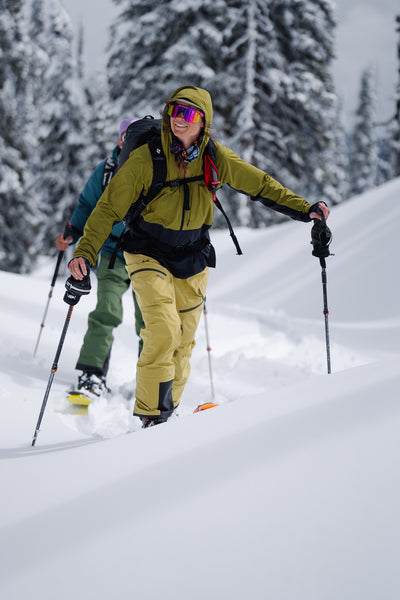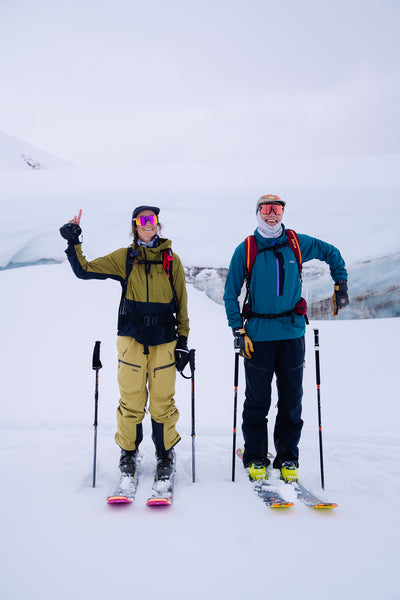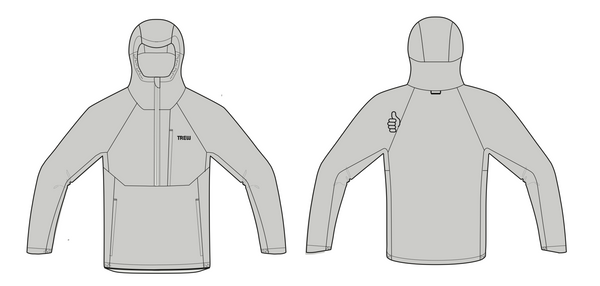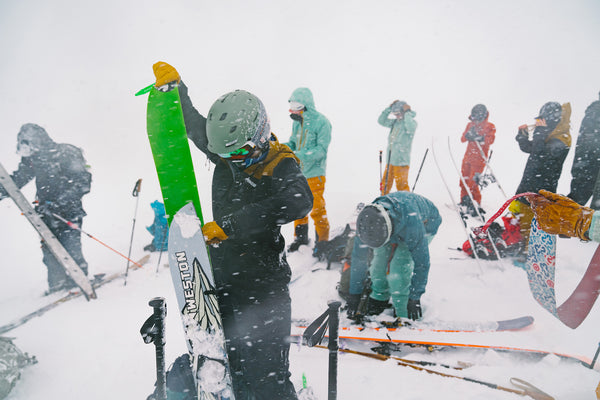What's Up with the Up Jack
Posté par Chris Pew le

What's up with the Up Jack?
TREW makes the gear to keep you comfortable while going up and down mountains, but we've always emphasized the down. We’re powder chasers at heart. Our full-coverage bibs, for example, don’t get the uphill crowd very excited. They are built to keep you dry while descending steep and deep lines, and they happen to tour and climb comfortably, too. But, again, priority is down.
The Up Jack is the outlier. It is designed to provide maximum utility on the up and all but disappear on the down.

It's the one piece of TREW that Marty and the Capow guides consistently sell to their clients at the Blanket Glacier Chalet while at the hut. It's the jacket that you didn't know you needed.
What's it for?
The Up Jack is an outer layer for going up the skin track. Its primary function is to block wind and weather. It also needs to be highly breathable and lightweight. We wanted to make a jacket that you couldn't even notice when you're wearing and would keep you comfortable in various weather conditions.

Up Jack Fabric Development
The Up Jack fabric 100% nylon ripstop fabric with mechanical stretch. This maximizes the strength-to-weight ratio compared to nylon/lycra blends or polyester, which is usually less durable in delicate denier fabrics. Our fabric is relatively heavy compared to other windbreakers for running or cycling. We used a 40d yarn compared to a 20d that you might find on ultralight windbreakers. We made this decision for extra durability and comfort. It also makes this jacket more optimized for heavy winter weather than a windbreaker designed for Spring or Summer.
For the woven fabric to block wind, it needs to have a coating or a cire finish. A cire is the shiny appearance you see on many lightweight fabrics. It is achieved through heat and pressure, essentially putting a slight “burn” on the nylon fabric. Many “windbreakers” you see out there have a cire finish, but it is most common on insulated jackets because this finish makes it fiber-proof. The cire finish is not desirable for the Up Jacket because it significantly decreases breathability. If you've had a lousy experience touring in a windbreaker in the past, this fabric likely had a cire finish.
Instead, we opted for a water-based acrylic coating. We have also used polyurethane coatings in the past. These coatings function like our nonporous membrane by “pushing” your body's vapor through the coating to the exterior. The fabric and the coating are so thin that this is relatively efficient. In our experience, the acrylic coating has an advantage over the polyurethane because it's more durable.
We also finish our Up Jack fabrics with a PFAS-free DWR coating to help shed light moisture.
Behind the design of the Up Jack
The Up Jack is a minimalist pullover jacket with sparse features. The function of the product comes mostly from the performance and feel of the fabric itself.
We designed the Up Jack as a pullover to decrease the weight and make the piece more durable over time (center front zippers are often the first component to fail after many years). We've always had one chest pocket large enough to fit everyday things like a cell phone or a VHF radio (with the antenna sticking out) for the guides. We have often opted for a pass-through, hoodie-style pocket. The benefit of this pocket is a large storage area where you can stuff things while moving. For example, I use the hoodie pocket to stuff gloves, hats, and sunglasses while touring and don't want to stop and take my pack off.

The Up Jack has built-in elastic on the cuffs, hood, and hem. The hood is large enough to fit over hats and alpine climbing helmets. This season, it is cut wider to drape more fabric on the side of your face to help block the weather or sun.
How do you wear the Up Jack?
Wearing just a merino base layer and a jacket like the Up Jack, an uphill-traveling backcountry skier can be comfortable in pretty much any weather. The Up Jack blocks the chill from the exterior while effectively trapping enough heat from your body to create the perfect microclimate. We recommend merino wool as the base layer because it is an effective insulator and wicking fabric.
When you're ready for your descent, we recommend throwing your outer shell over your Up Jack. That way, you don't have to take off and store layers in your pack, although you certainly could. We intentionally designed the Up Jack to be extremely packable. However, it's so thin, lightweight, and breathable that you literally don't need to take it off all day. Plus, when it’s windy, who wants to shed layers during a transition?

Wear it on the uphill, throw on your jacket for the descent, and pack your shell for the next ascent, and you're ready to go.
Spend a day touring with Marty in the Monashees, Shane in the Cascades, or Gilles in the Alps, and the only time you'll find them without an Up Jack on is when they're sleeping.
Designed for the up track, up for anything.
There are plenty of windbreakers on the market. We made the Up Jack because none are specifically designed for backcountry touring. We know that any splitboarder or backcountry skier will enjoy the simple functionality and comfort of the Up Jack. But once you own a piece like the Up Jack, you’ll find it useful for any outdoor mission. It’s UP for anything.
← Ancienne article Nouvelle article →
0 commentaire

